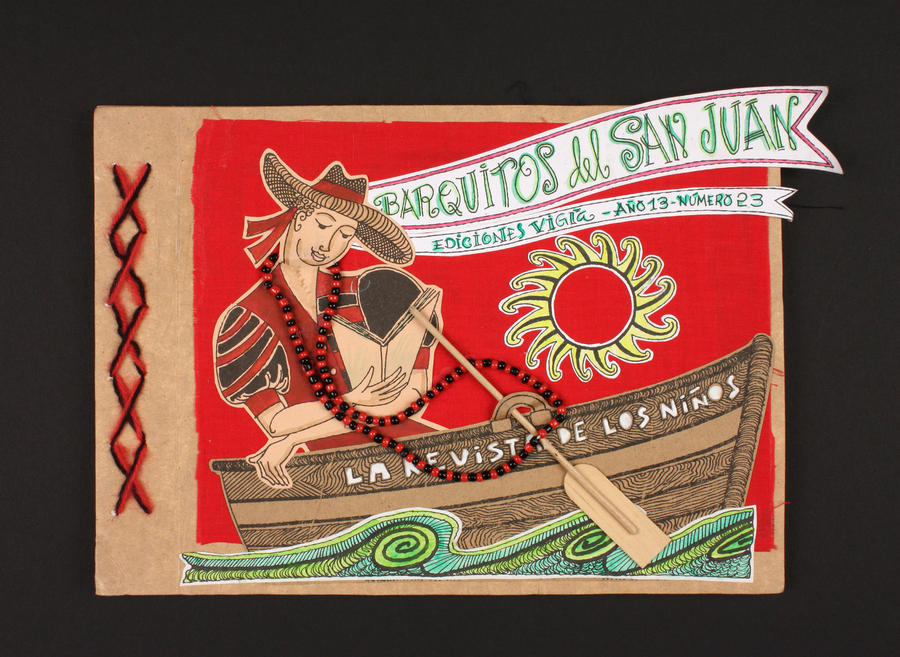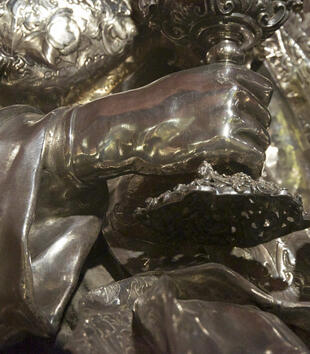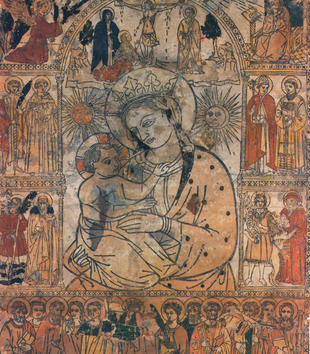Rolando Estévez Jordán, a visual artist, and Alfredo Zaldívar, a poet, co-founded Cuba’s Ediciones Vigía (Watchtower Editions) in 1985 to create an open forum for writers, musicians, and artists.1 They began by creating single-sheet flyers to advertise meetings, but their venture soon evolved into a publishing house that now produces limited edition handmade books and journals. Typically designed by Estévez and assembled by artisans, the publications are celebrated for the sophisticated interaction of word and image, the use of repurposed and recycled materials, the presence of flaps, pop-up illustrations, pull-down scrolls, and movable parts, and the active and multi-sensory engagement they demand of reader-viewers.
A 2007 issue of Vigía’s magazine for young people, Barquitos del San Juan, features a young man reclining in a rowboat wearing a red and black striped tunic with exaggerated short sleeves, one striped, the other solid. The young man’s fine facial features suggest that he is Afro Cuban and his attire, recalling that of a medieval jester, identifies him as Elegua, one of the most important orishas2 in la regla de ocho (the rule of eight), a religious worldview and practice popularly known as Santería.3 Elegua is the god of the threshold and the crossroads, a paradoxical figure who embodies openings and closings, life and death, light and dark, day and night. He is also irascible, testing people’s faith, playing childlike pranks, and tripping up unsuspecting travellers.4
The use of Elegua for a children’s magazine is particularly appropriate since the orisha’s most popular Roman Catholic counterpart is El Santo Niño de Atocha (the Holy Child of Atocha).5 The two share similar mythologies—they guide and protect travellers—and iconographic features— they are depicted as children with wide-brimmed hats, ornate and often ruffled clothing, and staffs. In addition to serving as a point of identification with young readers, Elegua’s reputation as a mischievous trickster emphasizes the playfulness and humor of many of the poems, riddles, and short stories that fill the issue’s pages.
Estevéz contributes to the issue’s focus on Elegua by employing the orisha’s ceremonial roles and familiar attributes to shape the reader-viewer’s interaction with the magazine.6 Elegua, the first orisha to be invoked at initiation rituals, summons the reader-viewer into the issue through his appearance on the cover. Just as the orisha stations himself at entryways and unlocks doors, so he introduces each new section of the magazine. Finally, Elegua’s constant vigilance leads him to peak out from behind the outer edge of each manuscript page, waiting for an opportunity to test the reader-viewer and offer alternatives that might bring good fortune but could also result in adversity.
By using Elegua as a ritual evocation, as a structural element, and as a repeating motif, Estevéz links critical reading and viewing to Elegua’s watchfulness and to the vigilance he elicits in believers. Estevéz intimates that this issue of the magazine "hosts" Elegua, as well as the chicanery he embodies, by christening the boat on the cover "La Revista de Niños." He more broadly identifies the press with Elegua on the back cover, where the orisha lies sleeping in a rowboat. Here the boat is named "Ediciones Vigía Mantanzas Cuba," and the orisha is juxtaposed with the press’s symbol, the oil lamp. In this way, Estevéz avows that both Elegua and Vigía are perpetually vigilant; they provide a light and guide the way. Neither guarantees, however, that the route they suggest is the right one to take. Like practioners of Santería, reader-viewers of this issue of Barquitos del San Juan should be wary; Elegua is not always a trustworthy guide.
Estevéz’s equation of Vigía and Elegua underscores the continuing impact of the press’s origins in the 1980s on its convictions regarding art’s cultural work. While Cuba’s "stagnation period" in the 1970s was marked by the marginalization of artists, the cultural renaissance of the 1980s was celebrated for the production of art that searched for Cuban and Afro-Cuban identities, embraced popular culture, engaged in social critique, and challenged the production-consumption model of art.7 Vigía continues to call its reader-viewers to be critical, yet contribute to Revolutionary ideals, to be independent, yet participate in community, to be global, but attend to national concerns, and to be attentive, always, to the possibilities that can lead alternately to repression or to freedom.



